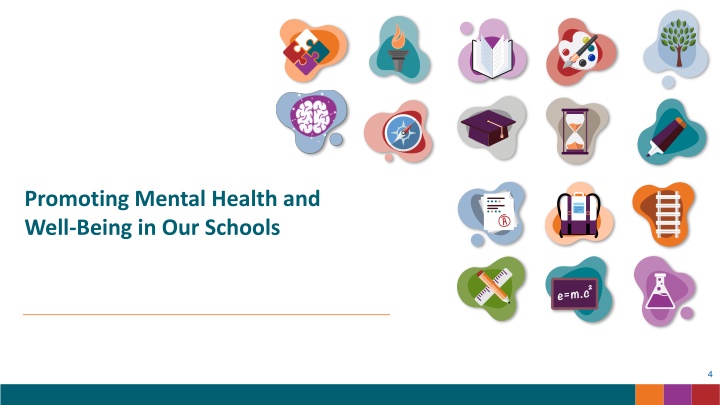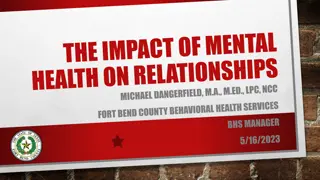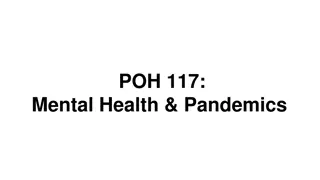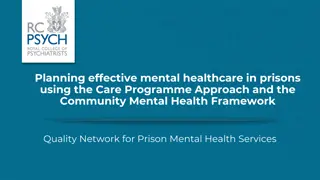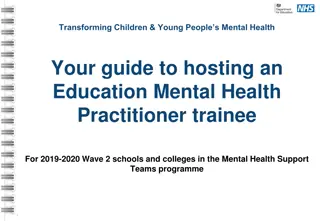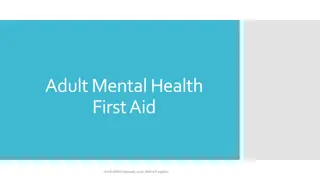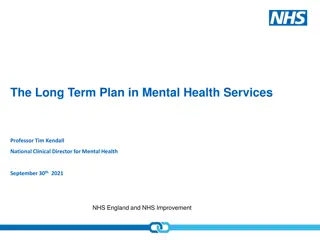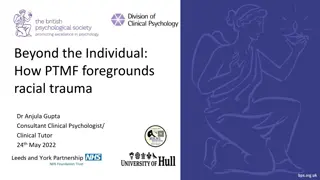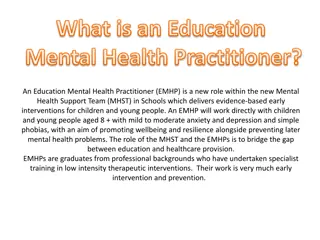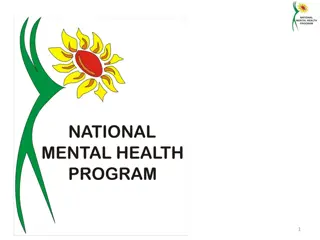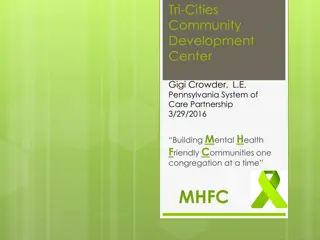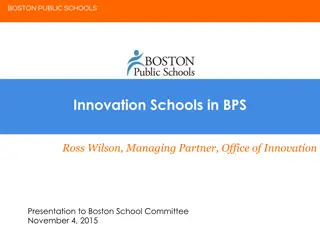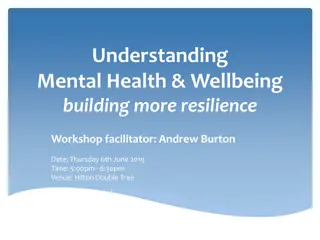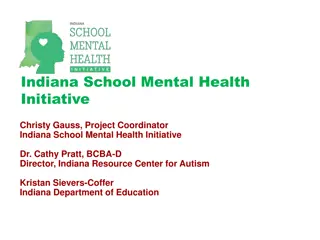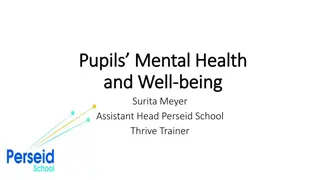Strategies to Promote Mental Health in Schools
Schools play a crucial role in promoting mental health and well-being among students. By focusing on prevention, early intervention, and creating supportive environments, schools can help reduce school absenteeism, risky behaviors, and substance use. Six evidence-based strategies include providing psychosocial skills training, enhancing connectedness, promoting social-emotional learning, increasing mental health literacy, supporting staff well-being, and promoting mindfulness.
Download Presentation

Please find below an Image/Link to download the presentation.
The content on the website is provided AS IS for your information and personal use only. It may not be sold, licensed, or shared on other websites without obtaining consent from the author.If you encounter any issues during the download, it is possible that the publisher has removed the file from their server.
You are allowed to download the files provided on this website for personal or commercial use, subject to the condition that they are used lawfully. All files are the property of their respective owners.
The content on the website is provided AS IS for your information and personal use only. It may not be sold, licensed, or shared on other websites without obtaining consent from the author.
E N D
Presentation Transcript
Promoting Mental Health and Well-Being in Our Schools 4
Why Focus on Mental Health and Well-Being? When youth experience poor mental health, they are also at increased risk of school absence and dropout, risky sexual behavior, and illicit substance use.2,3 In 2021 42% of high school students reported feeling sad or hopeless for at least 2 weeks in the past year Some groups of youth experience worse mental health outcomes:1,4,5 22% of high school students reported that they had seriously considered suicide4 Female students Lesbian, gay, bisexual, transgender, queer, or questioning students (LGBTQ+) Students who have experienced racism in school 5
What Can Schools Do? Promote the mental health and well-being of students through education, prevention, and early intervention efforts. Provide safe and supportive environments that connect students to caring adults and encourage positive peer relationships. Link students and families to mental and behavioral health services when needed. 6
Promoting Mental Health and Well-Being in Schools: An Action Guide for School and District Leaders 7
Six Evidence-Based Strategies to Support Mental Health and Well-Being in Schools Provide Psychosocial Skills Training and Cognitive Behavioral Interventions Enhance Connectedness Among Students, Staff, and Families Promote Social, Emotional, and Behavioral Learning Increase Students Mental Health Literacy Support Staff Well-Being Promote Mindfulness 8
What are we already doing well to support mental health and well-being? 10
What new approaches are most important to put in place in the next academic year? 11
Equity: How will we meet the diverse needs of our students and staff? 15
Increase Students Mental Health Literacy (1) Team: Equity Considerations: Deliver classroom-based mental health education curricula This approach has been found to Decrease stigma related to mental health Engagement with Partners: Implementation Support: Increase mental health knowledge and positive attitudes about mental health treatment Increase the number of students asking for help with mental health Timeline: 19
Increase Students Mental Health Literacy (2) Team: Equity Considerations: Use peer-led modeling programs This approach has been found to Increase positive attitudes about coping with challenging situations Engagement with Partners: Implementation Support: Increase the acceptability of asking for help Increase students perception that adults can provide support related to mental health Timeline: 20
Promote Mindfulness (1) Team: Equity Considerations: Deliver classroom-based mindfulness education This approach has been found to... Decrease anxiety Engagement with Partners: Implementation Support: Decrease depressive symptoms Decrease negative coping behaviors Increase positive coping behaviors Timeline: 21
Promote Mindfulness (2) Team: Equity Considerations: Dedicate time for students to independently practice mindfulness This approach has been found to... Decrease anxiety Engagement with Partners: Implementation Support: Increase resilience Timeline: 22
Promote Mindfulness (3) Team: Equity Considerations: Offer small-group mindfulness activities This approach has been found to... Decrease stress Engagement with Partners: Implementation Support: Decrease depressive symptoms Decrease internalizing behaviors (e.g., feelings of anxiety, withdrawal, and depressive symptoms) Timeline: 23
Promote Social, Emotional, and Behavioral Learning Throughout the School (1) Team: Equity Considerations: Provide classroom instruction focused on building social skills and emotional development This approach has been found to... Decrease anxiety Decrease depressive symptoms Decrease internalizing behaviors (e.g., feelings of anxiety, withdrawal, and depressive symptoms) Increase mental health and well-being Increase resilience Engagement with Partners: Implementation Support: Timeline: 24
Promote Social, Emotional, and Behavioral Learning Throughout the School (2) Team: Equity Considerations: Offer targeted education focused on teaching social skills and emotional development This approach has been found to... Decrease anxiety Engagement with Partners: Implementation Support: Decrease depressive symptoms Decrease internalizing behaviors (e.g., feelings of anxiety, withdrawal, and depressive symptoms) Timeline: 25
Enhance Connectedness Among Students, Staff, and Families Team: Equity Considerations: Provide relationship-building programs This approach has been found to... Decrease internalizing behaviors (e.g., feelings of anxiety, withdrawal, and depressive symptoms) Engagement with Partners: Implementation Support: Timeline: 26
Provide Psychosocial Skills Training and Cognitive Behavioral Interventions (1) Team: Equity Considerations: Promote acceptance and commitment to change This approach has been found to... Decrease somatic symptoms (physical reactions to emotional distress e.g., dizziness, nausea, chest pain) Engagement with Partners: Implementation Support: Decrease depression Increase coping Timeline: 27
Provide Psychosocial Skills Training and Cognitive- Behavioral Interventions (2) Team: Equity Considerations: Provide cognitive behavioral interventions This approach has been found to... Decrease anxiety Engagement with Partners: Implementation Support: Decrease depressive symptoms Decrease internalizing behaviors (e.g., feelings of anxiety, withdrawal, and depressive symptoms) Decrease posttraumatic stress Timeline: 28
Provide Psychosocial Skills Training and Cognitive- Behavioral Interventions (3) Team: Equity Considerations: Engage students in coping skills training groups This approach has been found to... Decrease anxiety Engagement with Partners: Implementation Support: Decrease depression Increase coping Timeline: 29
Support Staff Well-Being (1) Team: Equity Considerations: Offer mindfulness-based training programs This approach has been found to... Decrease anxiety Engagement with Partners: Implementation Support: Decrease depressive symptoms Decrease stress Increase well-being Timeline: 30
Support Staff Well-Being (2) Team: Equity Considerations: Provide therapeutic resources This approach has been found to... Decrease anxiety Engagement with Partners: Implementation Support: Decrease depressive symptoms Decrease stress Timeline: 31
References 1. Centers for Disease Control and Prevention. Youth risk behavior survey: Data summary and trends report, 2011-2021. Accessed May 26, 2023. https://www.cdc.gov/healthyyouth/data/yrbs/pdf/YRBS_Data-Summary- Trends_Report2023_508.pdf Conway KP, Swendsen J, Husky MM, He JP, Merikangas KR. Association of lifetime mental disorders and subsequent alcohol and illicit drug use: results from the National Comorbidity Survey Adolescent Supplement. J Am Acad Child Adolesc Psychiatry. 2016;55(4):280-288. https://doi.org/10.1016/j.jaac.2016.01.006 Finning K, Ukoumunne OC, Ford T, Danielsson-Waters E, Shaw L, De Jager IR, Stentiford L, Moore DA. The association between child and adolescent depression and poor attendance at school: A systematic review and meta-analysis. J Affect Disord. 2019;245:928-938. https://doi.org/10.1016/j.jad.2018.11.055 Mpofu JJ, Cooper AC, Ashley C, Geda S, Harding RL, Johns MM, Spinks-Franklin A, Njai R, Moyse D, Underwood JM. Perceived racism and demographic, mental health, and behavioral characteristics among high school students during the COVID-19 pandemic Adolescent Behaviors and Experiences Survey, United States, January June 2021. MMWR Supplements. Apr 1 2022;71(3):22-27. https://doi.org/10.15585/mmwr.su7103a4 Johns MM, Lowry R, Andrzejewski J, et al. Transgender Identity and Experiences of Violence Victimization, Substance Use, Suicide Risk, and Sexual Risk Behaviors Among High School Students 19 States and Large Urban School Districts, 2017. MMWR Morb Mortal Wkly Rep 2019;68:67 71. https://dx.doi.org/10.15585/mmwr.mm6803a3 2. 3. 4. 5. 33
